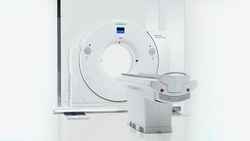
Posted to News on 27th Jul 2016, 15:20
Mechatronics drive system ensures positioning accuracy
Schaeffler has worked closely with Siemens Healthcare to develop a drive system that enables computer tomography (CT) machines to be moved from one hospital treatment room to another. This will benefit patients, as they can now be diagnosed more quickly after a stroke.

Siemens Healthcare was responsible for the CT machine itself, the imaging technology and scanner control system, while Schaeffler contributed the entire mechatronics drive system. This includes the rail guidance system, the floor module, the drive technology, the cable column and the ceiling cassette, which guides all of the supply lines required by the CT machine. Schaeffler also supplied the drive electronics for the rail guidance system.
As you would expect from a medical application, the requirements specification is very demanding - particularly when it comes to the precision of the travel motion. The floor module, for example, must reach its target position with a maximum tolerance of just 0.5mm - irrespective of whether the machine has traveled a few centimetres or several metres. The speed at which the extremely heavy CT machine is moved can be from 1mm/s to 120mm/s, which again must not affect the target position. What is more, the CT machine must also be brought to a complete stop within 10mm if its impact protection system identifies an obstruction in its travel path. Henning Dombek, Vice President of System Solutions at Schaeffler Linear Technology, states: "The Sliding Gantry system developed by Siemens and Schaeffler is the first travel drive in the world to fulfill these requirements."
Time is money. You don't have to be a stressed-out manager to know that. For Wolfgang Reith - doctor of medicine and director of the Diagnostic and Interventional Neuroradiology clinic at the Saarland University Hospital in Homburg (Saar) - time means brain function, i.e. how much brain function is retained after a stroke.
Reith explains: "Two million neurons die every minute," That is why time is such a decisive factor. It's about more than just calling an emergency physician and minimising the time it takes to get the patient to hospital. Reith continues: "Too much time is wasted when patients have to be moved from the emergency unit to a specialist department so that the condition of their blood vessels can be checked using an imaging process." Reith can now tell whether his stroke patient has a circulation disturbance or a brain haemorrhage - this differentiation is essential, because only after it has been made can the correct treatment be determined.
The new "Sliding Gantry" technology developed by Schaeffler and Siemens eliminates the problematic time factor and reverses the technological principle that has been used to date. CT machines are normally installed in a fixed location, with the patient passing through the machine on a moving bed during the examination. The term "Sliding Gantry" refers to the entire rail guidance system, including the drive, which moves the CT machine while the patient remains stationary on the treatment table. The decisive benefit comes from the fact that a rail guidance system several metres in length can be used to move the Sliding Gantry directly between adjacent rooms, e.g. from the routine scanning room to the trauma room.
On the spot examinations
Dr Christoph Dickmann, product manager at Siemens Healthcare explains: "The Sliding Gantry also opens up new possibilities when it comes to CT imaging in the operating room." When invasive treatment is carried out in or on blood vessels, the doctor must immediately recognise whether the treatment has been successful. At the same time, the operating team also has the space it needs, since the mobile CT machine can simply be moved out of the way when necessary.
When a patient has suffered multiple traumas, it's also very important to identify life-threatening injuries in various areas of the body as fast as possible. For this reason, a regulation has long been in existence by the German Society for Trauma Surgery stipulating that a full-body CT machine must be available 24 hours a day in close proximity to the trauma room. To date, however, this demand has often been difficult to meet because the capacity of such devices is used only to a small extent, which in turn makes it impossible to operate them in a cost-effective manner. Dickmann sees the new solution of sharing the Sliding Gantry between two rooms as an answer to this dilemma: "Whenever the CT machine is not needed in the trauma room, it is available for routine examinations in the adjacent room - and that significantly increases the level of utilisation for the investment." He also considers the system's use in other hospital departments as feasible, such as in CT interventions, routine examinations, and hybrid operating rooms.
Volume production within one year
Ralf Moseberg, the man responsible for linear technology at Schaeffler, recalls: "We completed the development within a year. The rapid implementation would not have been possible had we not had an intelligently configured modular system of components and sub-systems at our disposal."
1600 variations of the Sliding Gantry are currently available, which allow the system to be adjusted to suit the individual device and the hospital building. In other words, each one of these systems is unique. Henning Dombek, Vice President of System Solutions at Schaeffler Linear Technology explains: "We were still able to exploit the benefits of volume production."
And to ensure that nothing is left to chance when it comes to delivery quality, every Sliding Gantry is fully assembled and tested before it is delivered to Siemens. Henning Dombek of Schaeffler explains: "The installation of a new computer tomography machine with a Sliding Gantry should be a rapid and well-coordinated process."
This is why, for both Siemens and Schaeffler, there is only one goal: every system must reach the customer with absolutely zero defects within the specified timeframe. For more information, please visit www.schaeffler.co.uk.






























